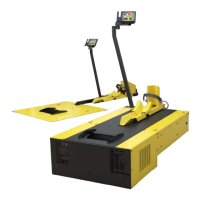
Do you have a question about the Dynojet 250i and is the answer not in the manual?
| Accuracy | ± 1% |
|---|---|
| Measurement Units | HP, kW, Nm |
| Resolution | 0.1 HP, 0.1 ft-lbs |
| Connectivity | Ethernet |
| Power Supply | 50/60 Hz |
Introduces the dynamometer and the manual's scope, detailing product benefits and safety.
Explains symbols, conventions, and provides contact information for Dynojet technical support.
Discusses optimal dyno room design elements including noise reduction and ventilation.
Details battery requirements and physical dimensions of the dynamometer chassis.
Outlines requirements for compressed air and computer specifications for software operation.
Specifies electrical power needs and environmental operating conditions for the dyno.
Covers grounding, connectivity, and specific tools needed for installation and operation.
Illustrates components of Model 200i/250i and details DynoWare RT electronics.
Explains how to connect the DynoWare RT to a computer or local network.
Details steps for safely unloading and checking the dyno for damage upon arrival.
Provides step-by-step instructions for safely lifting the dyno off its crate base.
Details the procedure for properly routing the dyno's main power cable.
Guides the installation of the required battery into the dynamometer.
Guides the installation of the electronic pickup card for RPM sensing.
Covers the installation of the optional eddy current brake accessory.
Provides instructions for installing the optional load cell and its calibration.
Describes how to anchor the dyno and brake module to the concrete floor.
Guides the installation of the articulated arm and platform for monitor and keyboard.
Details how to identify and route various cables for dyno components.
Explains how to slide the DynoWare RT main module into its bracket.
Details how to connect the control panel cable to the main module.
Provides instructions for installing the tire carriage assembly onto the dyno.
Details how to reinstall the side covers after component installation.
Instructions for attaching a custom ramp to the dyno using a bracket.
Guides the installation of ground hooks for securing motorcycles on the dyno.
Explains how to use the zip tube to organize and protect cables.
Details how to connect and disconnect power to the dynamometer.
Covers air brake installation, cable routing, and final adjustments.
Explains how to apply the emergency stop sticker to indicate added functionality.
Provides instructions for replacing the brake pads on the dynamometer.
Details how to adjust the brake pad clearance for optimal performance.
Introduces the Air Fuel Ratio module and its installation requirements.
Describes the extended carriage option for increased wheelbase compatibility.
Introduces the folding ramp accessory for easier motorcycle loading.
Introduces the high pressure blower accessory for engine cooling.
Introduces the power carriage option for electric tire adjustment.
Introduces the wheel clamp accessory for securing the front tire.
Covers final checks and tests after installing accessories and routing cables.
Provides an overview of the control panel interface and its functions.
Describes the features and functions of the control panel for dyno operation.
Explains how to control blowers and understand interlock safety circuits.
Details operation of power carriage, starter, and interpreting status indicator.
Details how to operate the wheel clamp using the control panel.
Describes the circuit breakers within the CPI for power distribution.
Covers basic maintenance and troubleshooting for the wheel clamp and fuses.
Guides the replacement of fuses for the eddy current brake driver.
Details the function of CPI fuses and troubleshooting steps.
Provides an overview of the chapter on basic dyno operation.
Details the steps for safely loading a motorcycle onto the dyno.
Explains how to connect inductive pickups for RPM measurement.
Details the procedure for grounding the vehicle to the dyno before each run.
Outlines essential checks to perform before starting a dyno run.
Explains starter usage and directs users to Power Core Help for dyno operation.
Provides steps for conducting a safe and accurate dynamometer test run.
Recommends routine checks to maintain proper dynamometer operation.
Highlights safety precautions required when installing anchors.
Details the procedure for drilling holes and installing Red Head anchors.
Details power requirements and installation for 60 Hz regions.
Specifies power outlet requirements and installation for 60 Hz areas.
Explains how to test receptacle voltages before connecting the dyno.
Provides instructions for directly wiring the dyno to the building's power.
Outlines power requirements and installation for regions outside NA and Japan.
Explains how to test receptacle voltages for non-NA/Japan regions.
Provides instructions for directly wiring the dyno for non-NA/Japan regions.
Provides instructions for installing the EEC finger guards.
Explains the necessary step of removing the drum module hood before guard installation.
Explains how to adjust the clearance of the EEC finger guards.
Details the installation and function of the door safety switch.
Lists standard bolt torque values based on size and grade.
Lists metric bolt torque values for different grades and sizes.